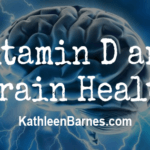Are you getting enough of the sunshine vitamin?
It may not surprise you to learn that most of us are not. In fact, prominent vitamin D researchers like Michael Holick, M.D., Ph.D. of Boston University, estimates that 95% of us are deficient in the winter. The number doesn’t change substantially in summer, when we’re out in the summer, but obsessed with slathering on sunscreens that block UVB rays of the sun, neutralizing the body’s ability to manufacture vitamin D.
Without sufficient stores of vitamin D, we are at risk for various types of cancer, obesity, diabetes, depression, heart disease, bone and joint diseases and more.
It did surprise me to learn that young people seem to be at particular risk for low vitamin levels today. One Harvard study showed that 24% of healthy teenagers were severely deficient with vitamin D levels below 15ng/ml and 42 percent had levels under 20 ng/ml, indicating serous deficiencies and increased risk for a variety of diseases.
Could it be because our teens spend so much time on their phones and playing video games rather than running around in the sunshine and fresh air?
The elderly have correspondingly low levels of vitamin D, as do people with dark skin tones.
Adding up those numbers, it becomes abundantly clear we have a serious national health problem.
Are you at risk of low D levels?
The answer is “yes” if you are:
- An indoor mole who rarely spends time outside
- A sunscreen addict who is fearful of skin cancer (Fact: The lack of vitamin D causes far more serious cancers)
- A resident of latitude as far north as Boston
- Overweight
- Over 65
- African-American or you have a dark skin tone
The easy answer is to have a 25 hydroxy-D blood test, in medical lingo, 25(OH)D. Don’t go for the 1,25(OH)2D—it doesn’t tell you if you’re getting enough vitamin D.
You‘ll need ask your doctor to write a prescription for the test, which is likely to be covered by health insurance. You will be sent to a lab and blood will be drawn with a needle.
You can also order an online test kit that requires you to do a finger prick
You can also get the test without a prescription at any of those storefront labs.
When you get the results, you’ll have the info you need to decide whether you need to supplement with vitamin D3.
The Vitamin D Council recommend an ideal level of 50 ng/ml. If your levels are lower than that, consider getting regular sun exposure in warm weather (even very fair-skinned people will not burn with a 15-20 minutes of noonday sun exposure three days a week. That is sufficient to help your body manufacture all of the vitamin you need.
If your levels are under 40, you’ll probably want to consider taking at least 5,000 IU of vitamin D3 supplements daily until you get up to 50 ng/ml.
The following post originally appeared on this blog on August 4, 2009. We felt it enhanced the information presented above.
Vitamin D benefits old, young, everyone
More and more studies are verifying the benefits of vitamin D for everyone at all stages of life and underscoring the premise that the majority of us are “D” deficient.
Recent contributions at both ends of life include a London School of Medicine study that adds to the evidence that higher vitamin D blood levels from supplements slow the aging process and the progress of age-related diseases.
There are several new studies on vitamin D and children. One of the most interesting shows that vitamin D deficiency appears to contribute to insulin resistance in obese African-American teenage girls. What’s more, increasing vitamin D levels can improve glucose tolerance, say researchers at the University of Alabama in Birmingham.
And according to a new Boston University study, vitamin D deficiency itself may be a contributor to the obesity epidemic among teenagers.
Mounting evidence for Vitamin D
There seems to be absolutely no question that most of us need more vitamin D and that getting sufficient amounts of the sunshine vitamin will provide protection against a host of deadly disease, perhaps even prolong your life.
I’ll be going into this information in greater detail in coming weeks as I prepare to publish a new book on the sunshine vitamin that is being kept in the dark. I promise you’ll learn everything about how vitamin D contributes to everything from healthy bones to a strong immune system to blood sugar balance and long life.
Get more sunshine
The message I want to convey today, here in the middle of summer, is how important sun exposure is to you vitamin D status.
The human body cannot manufacture vitamin D. It must get D from outside sources, and the sun is the best source. Best of all, it’s free!
You can get vitamin D from some foods and many foods, including dairy products, now have vitamin D added.
But why not get it from the sun when it’s so easy?
Ditch the sunscreen—for short exposures
The skin cancer scare has become a double-edged sward. While most light-skinned people need protection from long exposure to the sun, brief unprotected exposures will give you the vitamin D your body so desperately needs.
You don’t need a lot: Just go out for a 15-minute walk three times a week sans sunscreen. Be sure at least your face and arms are exposed and better yet, your legs, too.
Even if you’re very light-skinned, you won’t get burned in those brief exposures, but you will drink in that life-giving vitamin D.
Your body can store vitamin D or a certain period of time, so now in August you can store up your vitamin D against the winter when you’re not very enthusiastic about walking around coat-less and the sun’s rays are much weaker anyway.
Even if you’re really bulked up on your D levels, you’ll be running low by January or February. Low vitamin D levels have been shown to negatively affect mood, and that’s why many of us get the mid-winter blues. That’s nothing a week at the beach won’t cure, but if that’s not in your budget or work schedule, try some supplements.
Vitamin D supplements
All vitamin D supplements are not created equal. The natural form is vitamin D3 (cholecaliciferol), the type your body makes with sun exposure.
The American Journal of Clinical Nutrition says that vitamin D3 is the most powerful and most effective form of he vitamin, but, sadly, admits that most doctors prescribe formulations of vitamin D2 (ergocaliciferol), which has fewer beneficial effects and a shorter shelf life.
You’ll need to have your blood levels of vitamin D tested to determine if and how much of a supplement you should take. If you do, insist on a D3 formulation.
Better yet, get out there in the sun whenever you can.







